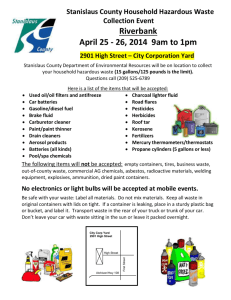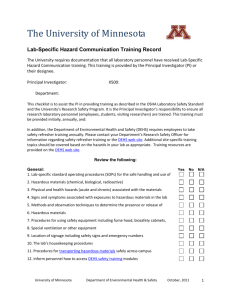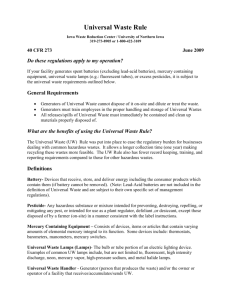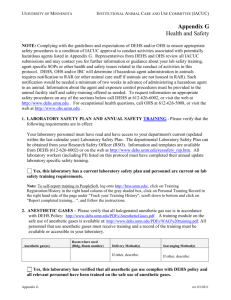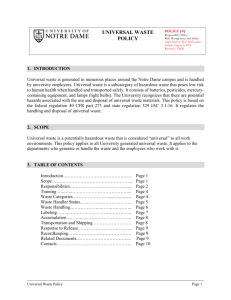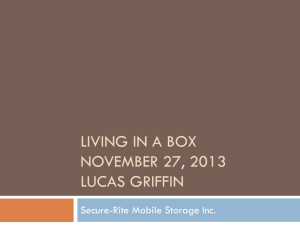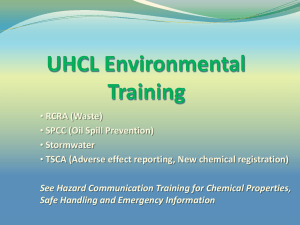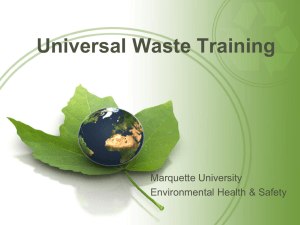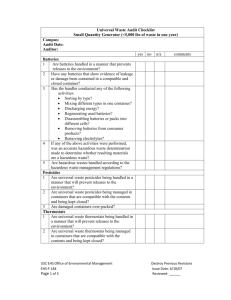Waste Chemical Disposal and Recycling Guidelines
advertisement
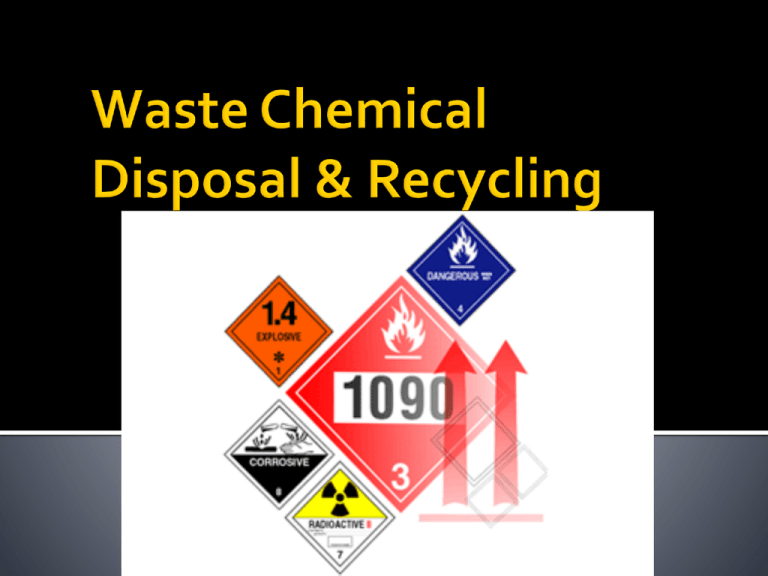
Fluorescent & other mercury lamps Batteries Solvents & wipes Oils & wipes or absorbents Paint wastes Aerosol cans Lamp ballasts Gas cylinders Unused chemical products 1. 2. 3. 4. 5. 6. 7. 8. Bring to designated location Complete Disposal Log Place waste in appropriate container or properly package Label container Place in secondary containment Separate incompatible waste Complete Waste Packing Form Send completed forms to Chemical Waste Program Como Recycling: Building 099, Garage Donhowe: Building 044, Rm SB05 Food Operations: Building 113, Rm 101 Heller Hall: Building 201, Rm 79 PWB Cage: Building 144, Rm B200B (Temporary Location) New Future Location - Mayo: Building 074, Room G109 St. Paul Shops: Building 379, 160B FACILITIES MANAGEMENT HAZARDOUS WASTE DISPOSAL LOG Name Dept/Unit Foreman or Supervisor Date Waste Description Approx. Quantity Type of Container Pack to avoid breakage If contents could leak, line boxes with heavy plastic bags Tape boxes closed Tighten drum caps Tighten closure rings/bands Replace this temporary band with one that has a bolt Lead acid batteries Leaking containers Avoid sparks from static electricity Ground drum Bond waste can to funnel/drum Drums, pails, boxes, etc Funnels latched closed and How to Handle Them Label "Used Oil" Used crank case oil, vacuum pump oil, lubricating oil, gear oil, automatic transmission fluid NO solvents, refrigeration oils, or transformer oils Oil and Solvent soaked rags and pads Store in red safety cans or steel drums Label as "Used Rags“ Oil with Floor Dry Store in steel drums Label as “Used Oil Floor Dry” Hazardous Waste Only used Paint Thinner Label as “Used Paint Thinner” Latex and oil-based paint and stains, epoxy paint, varnishes Place containers in bulk drum List on Disposal Log Metal or plastic cans only – no glass NO adhesives, resins, caulking tubes Rags, Rollers, Brushes, Filters If dry, regular trash If wet place in bag-lined steel drum Paint chips Collect Separately May have lead content Empty containers Less than 3% of container volume, if all waste that can be removed has been Recycle Metal Cans; Place in Scrap Metal bin Place Plastic containers in trash Empty (no contents or pressure) Recycle. Place in Maroon Cans and Bottles bin or scrap metal bin Not empty are Hazardous Waste Consolidate in bulk container Caps on, or remove valves PCB, Non-PCB, electronic ballasts can all go in the same barrel Label “PCB Ballasts” Fluorescent Treat as Hazardous Waste Fluorescent Compact Fluorescent Tube Metal Halide Sodium Sodium Mercury Vapor UV Germicidal Metal Halide UV Germicidal Use original container or any other box that will completely contain lamps Package similar used lamps together Remove cardboard shipping positioning end pieces Do not cut the box end flaps off. Label container “Used Lamps” or “Lamps for Recycling” Keep containers closed Tape box closed when full Collect broken glass & other lamp pieces Wear gloves and safety glasses Use dust pan, cardboard,, etc. to avoid cuts Duct tape or damp cloth to get small pieces & powder Place in sealed container Label: "Hazardous Waste, Broken Lamps" Collection start and end date Drycell, Buttons, NiCads, Lead Acid Gel Cell… Label “Used Batteries for Recycling” Place small/med batteries in re-sealable buckets Palletize and label large lead-acid batteries Label “Used Batteries” Take directly to Como Garage Prevent shortcircuiting, damage to battery, & acid leakage Place in containment Use up or return to distributor or UStores Hazardous Waste Small cylinders of like hazard ▪ Package together Large Cylinders ▪ Put Packing Form on each cylinder Use up if possible Call Reuse Package separately Prevent from happening Label all containers Keep labels in good shape or replace Don’t let unknown chemicals accumulate Expensive to analyze and dispose Lab personnel must send to DEHS They should contact DEHS for help Do not take lab waste to FM storage rooms Some may be highly reactive, toxic, and DANGEROUS Keep separate: Acids from caustics/bases/alkalis Combustibles & flammables from acids & oxidizers Do not place chlorinated & PCB oil in regular used oil drum Separate by tray, cabinet, wall Call FM Safety or DEHS if unsure Evacuate Leave spill area Alert others in area and direct/assist them in leaving Confine Close doors and isolate the area. Prevent people from entering spill area Report From safe place, call DEHS ▪ 612-626-6002 during working hours ▪ 911 after hours Give your name, phone, location, spill location, name and amount of material spilled, extent of injuries, safest route to spill Stay by phone. DEHS will advise as soon as possible Cleanup High hazard releases (fire, health, reactivity hazard) DEHS or Fire Department will clean up or stabilize Small or low hazard spills, DEHS will advise you on what precautions and protective equipment to use FM to use for small, safe spills Yellow drums with sorbent, gloves, goggles, apron Questions / Comments?
